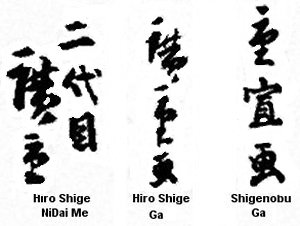| |
HIROSHIGE IISHIGENOBU
|
|
| HIROSHIGE II
(SHIGENOBU) Signatures |
Artist - HIROSHIGE-II
(二代目 歌川 広重 Ni-daime Utagawa HIROSHIGE), 1826 – 1869) was a
Japanese designer of ukiyo-e art. As chief pupil of HIROSHIGE
(I), he inherited his master's "go" name "HIROSHIGE" on
the latter's death in 1858, and is now principally known by it,
being more usually referred to as "HIROSHIGE-II". In 1865 he
moved from Edo to Yokohama after dissolving his marriage with
HIROSHIGE's daughter, and once again took his former art name
SHIGEOBU. Sometimes later he began using the art name ("go"
name) Kisai RISSHō (喜斎立祥; alternate pronunciation: RYūSHō). His
work resembles that of his master HIROSHIGE (I), that scholars
have often confused them, especially, when officially using his
former master's signature as his "go" name.
His earliest known work are the illustrations for a book called "Twenty-four Filial Pieties" (Confucian paragons of China and Japan) from 1849. During 1849-1858, he produced his earliest works, very much in the style of HIROSHIGE (I). His work were most often nature prints, although he also produced figure prints, and prints of samurai or historical subjects. He began signing with "ICHIYUSAI" (一幽斎), a former "go" name of HIROSHIGE (I) during this period.
He is thought to have assisted HIROSHIGE (I) with a number of his later series, including "36 Views of Fuji" and the "Vertical Tokaido". He is known to have contributed at least three prints in 10/1858 to HIROSHIGE (I)'s last great series of landscape prints, the "Hundred Views of Edo", using the signature 'Hiroshige' (during HIROSHIGE (I)'s lifetime).
After HIROSHIGE (I)'s death in 1858, in the first month of the following year, he formally adopted his master's "go" name of "ICHIRūSAI" (一立斎) and "HIROSHIGE" (広重), although he wrote it often as the old fashioned "廣重", an alternative spelling of "広重". During this period his work continued to strongly resemble that of HIROSHIGE (I), both in style and subject matter.
After moving to Yokohama in 1865, he produced a number of collaborative print series, particularly with KUNISADA, who had earlier been working with HIROSHIGE (I). In his final years he turned mainly to decorating works intended for export, such as tea chests, kites, and lanterns.
Personal life - He was born as Suzuki Chinpei (鈴木 鎮平) in 1826 into a family of fire-watchmen like his master HIROSHIGE (I). Apprenticed by HIROSHIGE, he was given the art name SHIGENOBU (重宣). He was made part of his master's household, and later married HIROSHIGE's daughter Tatsu (Oyatsu). After dissolving his marriage, he moved to Yokohama and remarried again. On 17 September 1869 he died at the early age of 44.
His fellow disciple at HIROSHIGE (I)'s studio had been SHIGEMASA (重政), better known as HIROSHIGE (III). HIROSHIGE (III) later married HIROSHIGE (II)'s divorced wife or HIROSHIGE (I)'s daughter Oyatzu (Otatsu or Tatzu).
Aliases - SHIGENOBU, His art names include"ICHIYUSAI" (一幽斎), a former "go" name of HIROSHIGE (I), "HIROSHIGE" (広重) after formally taking over his masters school in 1858, and Kisai RISSHō (喜斎立祥; alternate pronunciation: RYūSHō) after moving to Yokohama in 1865.
Disciples - Kisai Risshō II. (喜斎立祥 二代), active ca. 1865–70, Shigetsugu (重次) active until the end of Edo era, Hiroshige IV. (広重 四代) 1848–1925;
;
His earliest known work are the illustrations for a book called "Twenty-four Filial Pieties" (Confucian paragons of China and Japan) from 1849. During 1849-1858, he produced his earliest works, very much in the style of HIROSHIGE (I). His work were most often nature prints, although he also produced figure prints, and prints of samurai or historical subjects. He began signing with "ICHIYUSAI" (一幽斎), a former "go" name of HIROSHIGE (I) during this period.
He is thought to have assisted HIROSHIGE (I) with a number of his later series, including "36 Views of Fuji" and the "Vertical Tokaido". He is known to have contributed at least three prints in 10/1858 to HIROSHIGE (I)'s last great series of landscape prints, the "Hundred Views of Edo", using the signature 'Hiroshige' (during HIROSHIGE (I)'s lifetime).
After HIROSHIGE (I)'s death in 1858, in the first month of the following year, he formally adopted his master's "go" name of "ICHIRūSAI" (一立斎) and "HIROSHIGE" (広重), although he wrote it often as the old fashioned "廣重", an alternative spelling of "広重". During this period his work continued to strongly resemble that of HIROSHIGE (I), both in style and subject matter.
After moving to Yokohama in 1865, he produced a number of collaborative print series, particularly with KUNISADA, who had earlier been working with HIROSHIGE (I). In his final years he turned mainly to decorating works intended for export, such as tea chests, kites, and lanterns.
Personal life - He was born as Suzuki Chinpei (鈴木 鎮平) in 1826 into a family of fire-watchmen like his master HIROSHIGE (I). Apprenticed by HIROSHIGE, he was given the art name SHIGENOBU (重宣). He was made part of his master's household, and later married HIROSHIGE's daughter Tatsu (Oyatsu). After dissolving his marriage, he moved to Yokohama and remarried again. On 17 September 1869 he died at the early age of 44.
His fellow disciple at HIROSHIGE (I)'s studio had been SHIGEMASA (重政), better known as HIROSHIGE (III). HIROSHIGE (III) later married HIROSHIGE (II)'s divorced wife or HIROSHIGE (I)'s daughter Oyatzu (Otatsu or Tatzu).
Aliases - SHIGENOBU, His art names include"ICHIYUSAI" (一幽斎), a former "go" name of HIROSHIGE (I), "HIROSHIGE" (広重) after formally taking over his masters school in 1858, and Kisai RISSHō (喜斎立祥; alternate pronunciation: RYūSHō) after moving to Yokohama in 1865.
Disciples - Kisai Risshō II. (喜斎立祥 二代), active ca. 1865–70, Shigetsugu (重次) active until the end of Edo era, Hiroshige IV. (広重 四代) 1848–1925;
;
Copyright 2008 ff: Hans P. Boehme
